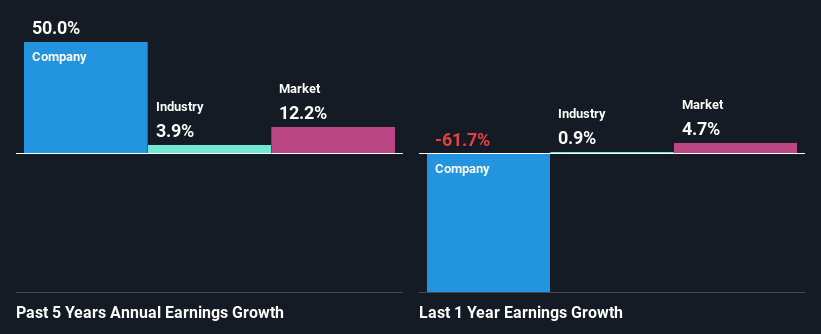- South Africa
- /
- REITS
- /
- JSE:FTA
Fairvest Limited's (JSE:FTA) Financials Are Too Obscure To Link With Current Share Price Momentum: What's In Store For the Stock?

Fairvest (JSE:FTA) has had a great run on the share market with its stock up by a significant 10% over the last three months. However, we decided to pay attention to the company's fundamentals which don't appear to give a clear sign about the company's financial health. Particularly, we will be paying attention to Fairvest's ROE today.
ROE or return on equity is a useful tool to assess how effectively a company can generate returns on the investment it received from its shareholders. Simply put, it is used to assess the profitability of a company in relation to its equity capital.
See our latest analysis for Fairvest
How To Calculate Return On Equity?
Return on equity can be calculated by using the formula:
Return on Equity = Net Profit (from continuing operations) ÷ Shareholders' Equity
So, based on the above formula, the ROE for Fairvest is:
8.6% = R667m ÷ R7.7b (Based on the trailing twelve months to September 2023).
The 'return' refers to a company's earnings over the last year. That means that for every ZAR1 worth of shareholders' equity, the company generated ZAR0.09 in profit.
What Is The Relationship Between ROE And Earnings Growth?
We have already established that ROE serves as an efficient profit-generating gauge for a company's future earnings. We now need to evaluate how much profit the company reinvests or "retains" for future growth which then gives us an idea about the growth potential of the company. Assuming everything else remains unchanged, the higher the ROE and profit retention, the higher the growth rate of a company compared to companies that don't necessarily bear these characteristics.
A Side By Side comparison of Fairvest's Earnings Growth And 8.6% ROE
It is quite clear that Fairvest's ROE is rather low. An industry comparison shows that the company's ROE is not much different from the industry average of 8.6% either. However, the exceptional 50% net income growth seen by Fairvest over the past five years is pretty remarkable. Given the low ROE, it is likely that there could be some other reasons behind this growth as well. For example, it is possible that the company's management has made some good strategic decisions, or that the company has a low payout ratio.
Next, on comparing with the industry net income growth, we found that Fairvest's growth is quite high when compared to the industry average growth of 3.9% in the same period, which is great to see.

The basis for attaching value to a company is, to a great extent, tied to its earnings growth. It’s important for an investor to know whether the market has priced in the company's expected earnings growth (or decline). This then helps them determine if the stock is placed for a bright or bleak future. One good indicator of expected earnings growth is the P/E ratio which determines the price the market is willing to pay for a stock based on its earnings prospects. So, you may want to check if Fairvest is trading on a high P/E or a low P/E, relative to its industry.
Is Fairvest Efficiently Re-investing Its Profits?
Fairvest's very high three-year median payout ratio of 116% suggests that the company is paying more to its shareholders than what it is earning. However, this hasn't hampered its ability to grow as we saw earlier. With that said, it could be worth keeping an eye on the high payout ratio as that's a huge risk. Our risks dashboard should have the 3 risks we have identified for Fairvest.
Along with seeing a growth in earnings, Fairvest only recently started paying dividends. Its quite possible that the company was looking to impress its shareholders.
Summary
On the whole, we feel that the performance shown by Fairvest can be open to many interpretations. While the company has posted impressive earnings growth, its poor ROE and low earnings retention makes us doubtful if that growth could continue, if by any chance the business is faced with any sort of risk. So far, we've only made a quick discussion around the company's earnings growth. So it may be worth checking this free detailed graph of Fairvest's past earnings, as well as revenue and cash flows to get a deeper insight into the company's performance.
New: AI Stock Screener & Alerts
Our new AI Stock Screener scans the market every day to uncover opportunities.
• Dividend Powerhouses (3%+ Yield)
• Undervalued Small Caps with Insider Buying
• High growth Tech and AI Companies
Or build your own from over 50 metrics.
Have feedback on this article? Concerned about the content? Get in touch with us directly. Alternatively, email editorial-team (at) simplywallst.com.
This article by Simply Wall St is general in nature. We provide commentary based on historical data and analyst forecasts only using an unbiased methodology and our articles are not intended to be financial advice. It does not constitute a recommendation to buy or sell any stock, and does not take account of your objectives, or your financial situation. We aim to bring you long-term focused analysis driven by fundamental data. Note that our analysis may not factor in the latest price-sensitive company announcements or qualitative material. Simply Wall St has no position in any stocks mentioned.
About JSE:FTA
Fairvest
A JSE and A2X-listed SA REIT (Real Estate Investment Trust) and the largest South African-focused property fund with a portfolio worth R12.0 billion.
Slight with acceptable track record.


